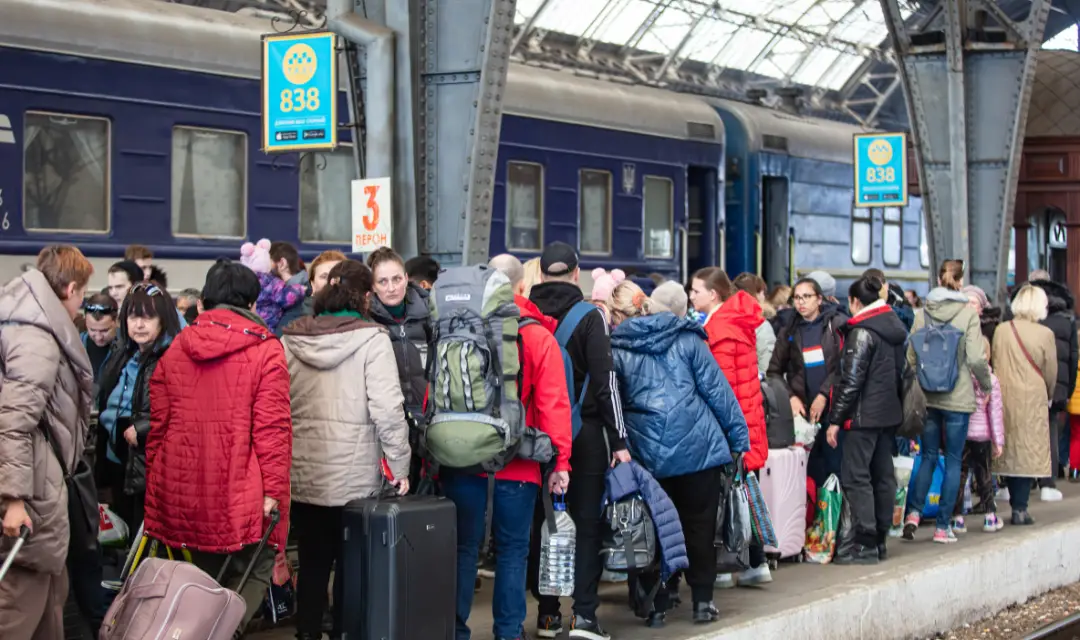Refugees are often viewed as some of the most vulnerable individuals globally. A shocking 108.4 million people had to leave their homes around the world by the end of 2022 because of abuse, war, or violations of human rights. This includes 35.3 million refugees, 62.5 million internally displaced people, 5.4 million asylum seekers, and 5.2 million people in need of international protection.
As of May 2023, the global count of displaced individuals had surpassed 110 million. This is the largest increase in forced displacement due to war and other deadly conflicts that UNHCR has ever seen. 1
The ongoing war in Ukraine has caught the attention of people all over the world. As of June 2023, more than 5 million Ukrainians had to leave their own country, and another 6.3 million had to leave their country for another one. Over 17 million people urgently require humanitarian assistance amid the devastating effects of the war.2
The succeeding discussion will help us further understand the distinctions among the different kinds of forcibly displaced people: refugees, asylum-seekers, stateless persons, and internally displaced persons.
As provided under Article 1 of the 1951 Convention, a refugee is someone who, “owing to well-founded fear of being persecuted for reasons of race, religion, nationality, membership in a particular social group, or political opinion, is outside the country of nationality and is unable or, owing to such fear, is unwilling to avail of the protection of that country; or who, not having a nationality and being outside the country of former habitual residence, is unable or, owing to such fear, is unwilling to return to it.”3
From this definition, we can infer the following requirements to be considered as refugee:
- well-founded fear of being persecuted for reasons of race, religion, nationality, membership of a particular social group or political opinion.
- outside the country of nationality or habitual residence
- is unable or, owing to such fear, is unwilling to avail of the protection of that country or unwilling to return to such country or habitual residence.
- not explicitly excluded from refugee protection or whose refugee status has not ceased because of a change of circumstances.
Once all requirements have been satisfied, such person will be considered as refugee. With the foregoing, it is not settled that the 1951 Convention only protects persons who meet the criteria for refugee status. However, there are certain categories of people that are excluded from refugee protection. This includes persons for whom there are serious reasons to suspect that:
- they have committed a crime against peace, a war crime, or a crime against humanity;
- they have committed a serious non-political crime outside their country of refuge prior to the admission to that country as a refugee; or
- they are guilty of acts contrary to the purposes and principles of the United Nations4
One of the core principles under the 1951 Convention is the Principle of Non-refoulement. As provided under Art. 33 of 1951 Convention, this principle asserts that a refugee should not be returned to a country where there is persecution or where they face serious threats to their life or freedom. This principle is the cornerstone of refugee protection.5
Among the rights afforded to refugees under the 1951 Convention are the right not to be expelled, except under certain, strictly defined conditions under Article 32, right not to be punished for irregular entry into the territory of a contracting State under Article 31, right to non- discrimination under Articles 3 and 5, right to decent work under Articles 17 to 19 and 24, right to housing, land and property, including intellectual property under Articles 13, 14 and 21, right to education under Article 22, right to freedom of religion under Article 4, right to access to justice under Article 16, right to freedom of movement within the territory under Article 26 & Article 31 (2), right to be issued civil, identity and travel documents under Articles 12, 27 and 28 and right to social protection under Articles 23 and 24 (2-4).
Relatedly, refugees are obliged to abide by the laws and regulations of their country of asylum and respect measures taken for the maintenance of public order.6 For example, an individual belonging to an ethnic minority who chooses not to engage in politics was forced to flee his country because he could not obtain protection from his government. Neighbors from the ethnic majority threatened him with death threats because he didn’t share their opinions. If he complies with the 1951 Convention’s standards, he may be declared a refugee in this circumstance.
Let us now go to the second classification which is an asylum-seeker. An asylum refers to the grant, by a State, of protection on its territory to persons outside their country of nationality or habitual residence, who are fleeing persecution or serious harm or for other reasons. Asylum includes a lot of different things, such as protection against being sent back to their home country, the right to stay in the asylum country, humane treatment, and the chance to find a long-term answer. Thus, an asylum-seeker is a general term for any person who is seeking international protection. In some countries, it is used as a legal term referring to a person who has applied for refugee status or a complementary international protection status and has not yet received a final decision on their claim. It can also refer to a person who has not yet submitted an application but may intend to do so, or may be in need of international protection. An asylum-seeker may not be sent back to their country of origin until their asylum claim has been examined in a fair procedure and is entitled to certain minimum standards of treatment pending determination of their status.7
Anyone can apply for asylum. Usually, it is a person who considers themselves at risk of serious harm in their country of origin, or who is compelled to leave their country in search of safety in another country.8
For instance, a member of a minority social group had to leave his country because he feared persecution from the dominant social group. As such, he may go to another country to seek asylum. During the pendency of his application as a refugee of the country of asylum, he may not be set back pursuant to the principle of non-refoulement, shall be treated in accordance with the universal declaration of human rights, and shall be afforded humanitarian aid.
On the other hand, Article 1 (1) of the 1954 Convention defines a stateless person as ‘a person who is not considered a citizen or a national by any State under the operation of its law’. This indicates that they lack citizenship in any particular nation.
For the majority of individuals, their nationality is established based on their place of birth, lineage, or a prolonged period of residing in a certain country. Certain individuals are born without a nationality, while others acquire statelessness at some point in their lives.9
Being stateless, they cannot enjoy the rights that are associated with citizenship, they are not afforded legal protection and are denied basic human rights such as education, food, healthcare, housing, and employment, among others.
According to the UNHCR, there are numerous reasons why statelessness can occur. These factors include discrimination against specific minority groups based on race, ethnicity, religion, language, or gender. Additionally, gaps in nationality laws or conflicts between countries’ laws can lead to the exclusion of individuals, rendering them stateless. For instance, a government may not confer citizenship just based on birth, but rather on the lineage of a citizen of that nation. If a foreign country does not permit parents to pass on nationality to their children through family ties, it can lead to the children becoming stateless. This can happen due to the emergence of new countries, transfers of territory between existing countries, or changes in borders that may exclude certain groups of people who struggle to prove their connections to a specific country. Additionally, the lack of birth registrations to verify a person’s place of birth and parentage, as well as denationalization resulting from prolonged residence outside one’s home country, can also contribute to statelessness.
As an illustration, a country may not grant nationality based on birth alone but based on descendance from a national. Children born in a foreign country may become stateless if the country does not allow their parents to pass on nationality through family ties, leaving entire generations stateless.10
Finally, the United Nations Guiding Principles on Internal Displacement say that internally displaced persons are “persons or groups of persons who have been forced or obliged to flee or leave their homes or places of habitual residence, in particular because of or in order to avoid the effects of armed conflict, situations of generalized violence, violations of human rights, or natural or human-made disasters, and who have not crossed an internationally recognized border.”
Because they are still inside their country, remain entitled to all the rights and guarantees as citizens and other habitual residents of their country. Additionally, they have access to the human rights stipulated by international human rights treaties and common law. In situations of armed conflict, moreover, they enjoy the same rights as other civilians to the various protections provided by international humanitarian law. Consequently, the governments of the states where internally displaced persons are found have the primary responsibility for their assistance and protection.11 As an example, due to a local armed conflict in a certain barangay in one region, thousands of individuals were displaced, according to national/regional disaster authorities, government.
Based on these definitions, we can notice that refugees, asylum seekers, stateless persons, and internationally displaced persons are all individuals who have been forced to leave their homes due to various circumstances. While they share similarities in terms of displacement, each of these categories has unique legal and distinct differences between these groups.
As a result, refugees flee their country due to a well-founded fear of persecution based on race, religion, nationality, membership in a particular social group, or political opinion. The reasons for asylum seekers are the same as those for refugees, the only difference is that their refugee status is still pending with the country to which they fled. On the other hand, statelessness can arise due to a variety of reasons, including gaps in nationality laws, state succession, or discrimination. While IDPs may be displaced due to conflict, persecution, or natural disasters.
As to legal status, every refugee is initially an asylum seeker, but not every asylum-seeker will ultimately be recognized as a refugee. An asylum-seeker may not be sent back to their country of origin until their asylum claim has been examined in a fair procedure and is entitled to certain minimum standards of treatment pending determination of their status. While asylum seekers may not have the same legal rights and protections as recognized refugees until their asylum claim is approved, refugees have been officially recognized as such by the host nation or by international organizations, and they are entitled to certain rights and protections under international law. Stateless persons do not have access to basic rights and services that are often associated with nationality, which confront them with serious legal challenges. Although they do not fall under the specific legal framework for refugees, they may acquire protection and assistance provided by national authorities or humanitarian organizations.
In terms of location, asylum seekers are frequently inside the borders of the country they have fled, awaiting a judgement on their asylum application, whereas refugees have crossed international borders and sought asylum in another nation. As to stateless persons, the majority of them were born in the countries in which they have lived their entire lives. Lastly, IDPs are still inside their country of origin and remain entitled to all the rights and privileges accorded by their country.
- Refugee Statistics, United Nations High Commissioner for Refugees. Retrieved on April 5, 2024[↩]
- Global Appeal 2024. United Nations High Commissioner for Refugees. Retrieved on April 5, 2024[↩]
- UNHCR – The UN Refugee Agency. (n.d.). The 1951 Refugee Convention[↩]
- UNHCR – The UN Refugee Agency. (n.d.-e). The 1951 Refugee Convention[↩]
- UNHCR – The UN Refugee Convention[↩]
- UNHCR – The UN Refugee Agency. (n.d.-c). Convention and Protocol relating to the status of refugees[↩]
- UNHCR – The UN Refugee Agency. (n.d.-g). UNHCR master glossary of terms[↩]
- UNHCR – The UN Refugee Agency. (n.d.-a). Asylum-Seekers[↩]
- About Statelessness. (n.d.).[↩]
- Ibid.[↩]
- OHCHR. (n.d.). About internally displaced persons[↩]




